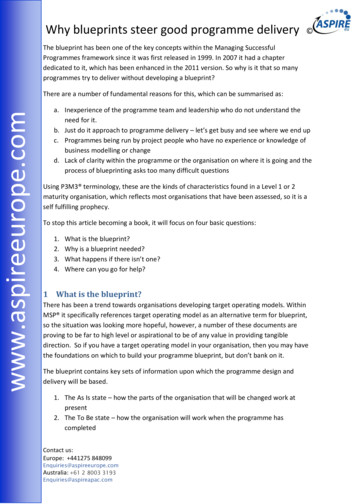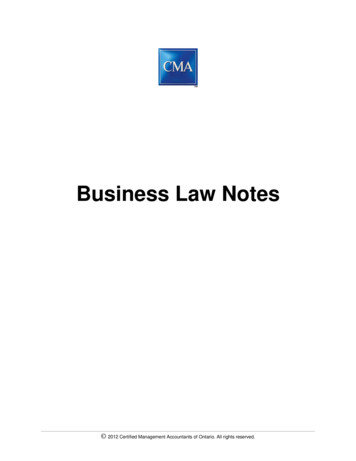HowToOperMaintSMSinternet
Table of Contents
Your SWMS. . .Your (SWMS) is designed and constructed to comply withcertain environmental protection criteria. Stormwater pondsand their associated surface water management facilities aredesigned to capture and remove pollutants from specificvolumes of stormwater runoff through processes such aspercolation, filtering and/or detention. As long as they areconstructed properly and maintained in an effective state, waterquality standards are presumed to be met.Surface water management facilities, such as ponds, ditchesand swales, are constructed to trap and filter out pollutants instormwater runoff from roads, parking lots, buildings andlawns. Discharge of untreated water to natural lakes, creeks,and rivers is harmful to natural vegetation and wildlife; thisdestroys one of the very things we like best about Florida —our enjoyment of the abundant clean water for recreation andaesthetic enjoyment.Stormwater management systems should be inspected on aroutine basis to ensure that they are functioning properly.Inspections should be scheduled on a monthly or quarterlybasis and following any major rain event. More frequentinspections may be necessary during the rainy season. Keepingdetailed notes on maintenance activities will help whenproviding a report to the Southwest Florida Water ManagementDistrict (District) at the time of your 18- or 24-month inspection.Environmental Resource Permit (ERP) or your Management andStorage of Surface Waters (MSSW) permit includes a conditionthat specifies how often the inspection reports are due.The purpose of this informational pamphlet is to provide theentity/permittee responsible for the operation and maintenanceof the Stormwater Management System (SWMS) with guidelinesfor establishing a program of routine maintenance procedures,which should minimize problems and maximize theappearance and performance of a SWMS.Typically, site developers are responsible for operation andmaintenance until construction is complete, then they arerequired by permit condition to transfer this responsibility to ahomeowners’, condominium owners’, or property owners’association. After an association is legally established andconstruction of the surface watermanagement system is completed,the association will assumeresponsibility. The operation andmaintenance entity for shoppingcenters, individual stores andoffices typically is the landowneror a management company hiredby the landowner.1It would be wise to designate one individual as the personresponsible for overseeing operation and maintenanceactivities, monitoring and reporting. This will allow thatindividual to become well acquainted with the SWMS.Provide this person with a copy ofthe permit and District-approvedconstruction drawings shouldquestions or issues develop.2
General MaintenanceGeneral Maintenance1. All stormwater pipes, inlets, catch basins, manholes,flumes, pond inflow and outfall structures (including oilskimmers), and discharge pipes should be inspected ona regular basis (monthly or quarterly) and after majorrainfalls. They should be maintained by removing builtup debris and vegetation and repairing deterioratingstructures.6. The approved Operation and Maintenance Permit and asbuilt drawings are available at your local District serviceoffice. Refer to those plans and permits or additionalrestrictions, instructions and conditions.7. It is usually more cost-effective to monitor and performroutine maintenance on a SWMS, rather than let it fail andhave to reconstruct the entire system.2. Chemicals, oils, greases or similar wastes are NOT to bedisposed of directly to the stormwater facility or throughstorm sewers. Treatment ponds are designed to treatnormal road, parking lot, roof and yard runoff only.Some chemicals may interfere with a treatment pond’sfunctions or kill vegetation and wildlife. Dispose of thesepotentially dangerous materials properly by taking themto recycling facilities or to collection locations sponsoredby many local governments.8. Mosquito growth can be minimized in a SWMS by thefollowing measures: Do not dump grass clippings or other organic debrisinto a SWMS — decaying grass clippings and otherdecomposing vegetation create ideal conditions forbreeding mosquitoes. Clean out any obstructions that get into the system.Debris can obstruct flow and harbor mosquito eggsand larvae.Also, do not dispose of grass clippings in a SWMS.Grass clippings pose problems by smothering desirablevegetation, clogging outfall structures and, when theydecompose, may cause unsightly algae blooms that cankill fish. Remove water lettuce and water hyacinth, whichnourish and shelter mosquito larvae. Stock ponds with predatory “mosquito fish” –Gambusia minnows, which may be collected fromother ponds and ditches and introduced into yourSWMS. Remember, the introduction of grass carp intoyour SWMS will require District approval.3. Accumulated pond sediments may contain heavy metalssuch as lead, cadmium and mercury, as well as otherpotentially hazardous materials. Therefore, sedimentsremoved from storm sewers, inlets, pipes and pondsshould be disposed of at an approved facility (check withyour county Solid Waste Department or the FloridaDepartment of Environmental Protection for disposalfacilities approved to accept treatment pond sediment).4. During any repair or maintenance activity, use care toavoid causing erosion or siltation to adjacent or off-siteareas.5. Remember, alterations (filling, enlarging, etc.) of anypart of the stormwater facility is not permitted withoutprior approval from all applicable governing agencies.continued on page 43continued from page 34
Stormwater Management System (AKA Percolation Ponds)(AKA Percolation Ponds)Dry Retention PondsDitches & Swales Some Environmental Resource Permits and (Management andStorage of Surface Water Permits) require that the vegetation insome ditches be protected to offset wetland impacts permittedduring construction or for water quality treatment. The permitor approved construction should clearly identify which ditchvegetation must be preserved. If you’re unsure, contact yourlocal District service office. If vegetation is not required to be protected, ditches and swalesshould be periodically mowed and cleaned of accumulatedrefuse. During the mowing operations, ditches and swalesshould be inspected for bare spots, damage or erosion. Bareareas should be sodded or seeded to replace the grass cover.In the case of erosion, replace the missing soils and bring thearea back to grade. Some ditches are designed to store runoff for short periods oftime utilizing ditch blocks or raised inlets. These ditch blocks orinlets should not be removed or altered.If you are unable to identify what type of treatment methodserves your development, contact your District service office.Addresses are on the back of this pamphlet.56
(AKA Percolation Ponds)Side-drain Filtration or Underdrain FiltrationDry Retention PondsEffluent FiltrationMAINTENANCE SUGGESTIONS 7 For maintenance suggestions see page 98
Effluent FiltrationWet Detention PondsSide-drain Filtration or Underdrain Filtration MAINTENANCE SUGGESTIONS For maintenance suggestions see page 11910
Wet Detention PondsMAINTENANCE SUGGESTIONS BROOKSVILLE (headquarters)2379 Broad StreetBrooksville, Florida 34604-6899(352) 796-7211 or 1-800-423-1476TAMPA7601 U.S. Hwy. 301 N.Tampa, Florida 33637-6759(813) 985-7481 or 1-800-836-0797BARTOW170 Century Blvd.Bartow, Florida 33830-7700(863) 534-1448 or 1-800-492-7862SARASOTA6750 Fruitville RoadSarasota, Florida 34240-9711(941) 377-3722 or 1-800-320-3503 Printed OnRecycled Paper11VISKH0003 (8/03)The Southwest Florida Water Management District (District) does not discriminate upon the basis of any individual's disability status. This nondiscrimination policyinvolves every aspect of the District's functions including one's access to, participation, employment, or treatment in its programs or activities. Anyone requiringreasonable accommodations as provided for in the Americans With Disabilities Act should contact the Communications Department at (352) 796-7211,extension 4757; TDD only 1-800-231-6103 (FL); fax (352) 754-6883; Suncom 663-6882 or view our Web site on the World Wide Web at WaterMatters.org.
Also, do not dispose of grass clippings in a SWMS. Grass clippings pose problems by smothering desirable vegetation, clogging outfall structures and, when they decompose, may cause unsightly algae blooms that can kill fish. 3. Accumulated pond sediments may contain heavy metals such as lead, cadmium and mercury, as well as other
If AutoCAD is open but you don’t have the same ribbon of tools across the top or the big black space to draw in then go to the next page. UNIVERSITY OF SHEFFIELD; LANDSCAPE DEPARTMENT AUTOCAD 2013/14/15 TUTORIALS - SESSION 1 Page 3 This next procedure is to create a NEW drawing to work on. Click on the red letter A on the top left of your screen Click on the ‘New’ button Your screen .
INSTRUMENTATION ENGINEERING For mechanical, instrumentation, electrical, and concrete data, a simple trend line produced a reasonable average. Correlating hours to the total mechanical equipment count did not produce a convergence (table 2, Mechanical 1). Mechanical 2 shows improvement to the correlation when the mechanical account was correlated separately to various equipment classes, pumps .
The blueprint has been one of the key concepts within the Managing Successful Programmes framework since it was first released in 1999. In 2007 it had a chapter dedicated to it, which has been enhanced in the 2011 version. So why is it that so many
Budidaya ikan air tawar sangatlah pantas sebagai usaha pemberdayaan masyarakat desa sumber harapan karena sesuai dengan potensi lokal yang ada dengan kita bisa melihat sumber daya alam yang mendukung. Sumber daya alam merupakan hal pendukung bagi kelangsungan budidaya ikan air tawar serta tidak terlupa dari peran sumber daya manusia yang mengelolanya supaya mampu memberikan hasil maksimal .
business entities, business relationships, and property rights—forms the substance of business law and is the main focus of this document. While the predominant concern in a business law course is substantive law, we will first consider the basics of procedural law, the form or organization of the legal system and its methods of conducting .
Compass 2019. VEHICLES SOLD IN CANADA With respect to any Vehicles Sold in Canada, the name . Fluid Level Standards 911 Contact and More Tip: When viewing a topic, tap the star icon to add it to your Favorites, for easy access in the future. 18 GETTING TO KNOW YOUR VEHICLE. KEYS
Cookbook guidelines are for closely spaced turns (touching on the inner diameter), and are summarized in Table 4. Noise Coupling and Transfer Impedance: Shielded cables have a property often quantified as their transfer impedance, which is the ratio of the differential voltage induced inside the coax to the . S S. S.
CQI-11 Special Process: Plating System Assessment Version 2 Issued 2/2012 Question Number Question Requirements and Guidance Objective Evidence N/A Satisfactory Not Satisfactory Needs Immediate Action 1.1 Is there a dedicated and qualified plating person on-site? To ensure readily available expertise, there shall be























